| [1] Bouwstra JA,Honeywell-Nguyen PL.Skin structure and mode of action of vesicles.Adv Drug Deliv Rev.2002;54 Suppl 1:S41-55.
[2] Green H,Kehinde O,Thomas J.Growth of cultured human epidermal cells into multiple epithelia suitable for grafting. Proc Natl Acad Sci U S A. 1979;76(11): 5665-5668.
[3] Bell E,Ivarsson B,Merrill C.Production of a tissue-like structure by contraction of collagen lattices by human fibroblasts of different proliferative potential in vitro. Proc Natl Acad Sci U S A.1979;76(3):1274-1278.
[4] Lee V,Singh G,Trasatti JP,et al.Design and fabrication of human skin by three-dimensional bioprinting.Tissue Eng Part C Methods.2014;20(6):473-484.
[5] Koch L,Deiwick A,Schlie S,et al.Skin tissue generation by laser cell printing.Biotechnol Bioeng.2012;109(7): 1855-1863.
[6] Bell E, Ehrlich HP, Buttle DJ,et al.living tissue formed in vitro and accepted as a full thickness skin equivalent. Science.1981;211(4486):1052-1054.
[7] Aasen T,Izpisúa Belmonte JC.Isolation and cultivation of human keratinocytes from skin or plucked hair for the generation of induced pluripotent stem cells.Nat Protoc. 2010;5(2):371-382.
[8] Carlson MW,Alt-Holland A,Egles C,et al.Three- Dimensional Tissue Models of Normal and Diseased Skin.Curr Protoc Cell Biol.2008;Chapter 19:Unit 19.9.
[9] Dragúňová J,Kabát P,Koller J,et al.Experience gained during the long term cultivation of keratinocytes for treatment of burns patients.Cell Tissue Bank. 2012; 13(3):471-478.
[10] Woodcock-Mitchell J,Eichner R,Nelson WG,et al.Immunolocalization of keratin polypeptides in human epidermis using monoclonal antibodies.J Cell Biol. 1982; 95(2 Pt 1):580-588.
[11] Papini S,Cecchetti D,Campani D,et al.Isolation and Clonal Analysis of Human Epidermal Keratinocyte Stem Cells in Long-Term Culture.Stem Cells.2003; 21(4):481-494.
[12] Lane EB.Monoclonal antibodies provide specific intramolecular markers for the study of epithelial tonofilament organization.J Cell Biol.1982;92(3):665-673.
[13] Rajan N,Habermehl J,Coté MF,et al.Preparation of ready-to-use, storable and reconstituted type I collagen from rat tail tendon for tissue engineering applications. Nat Protoc.2006;1(6):2753-2758.
[14] Tamilmozhi S,Veeruraj A,Arumugam M.Isolation and characterization of acid and pepsin-solubilized collagen from the skin of sailfish (Istiophorus platypterus). Food Res Int.2013;54:1499-1505.
[15] Techatanawat S.Type I collagen extracted from rat-tail and bovine Achilles tendon for dental application: a comparative study.Asian Biomed.2011;5:787.
[16] Laemmli UK.Cleavage of structural proteins during the assembly of the head of bacteriophage T4.Nature. 1970;227(5259):680-685.
[17] Junqueira L,Cossermelli W,Brentani R.Differential staining of collagens type I, II and III by Sirius Red and polarization microscopy.Arch Histol Jpn. 1978;41(3):267-274.
[18] 王雪,金剑,肖长发.疏水改性聚对苯二甲酸乙二醇酯的合成与表征[J].纺织学报,2011,32(4):12-17.
[19] Koster MI,Roop DR.The role of p63 in development and differentiation of the epidermis: Tanioku kihei memorial lecture.J Dermatol Sci.2004;34(1):3-9.
[20] Nelson WG,Sun TT.The 50-and 58-kdalton keratin classes as molecular markers for stratified squamous epithelia: cell culture studies.J Cell Biol.1983;97(1):244-251.
[21] Yang A,Kaghad M,Wang Y,et al.p63, a p53 homolog at 3q27–29, encodes multiple products with transactivating, death-inducing, and dominant-negative activities.Mol Cell. 1998;2(3):305-316.
[22] Liu SC,Karasek M.Isolation and growth of adult human epidermal keratinocytes in cell culture.J Invest Dermatol.1989;92(4 Suppl):164S;discussion 165S.
[23] Tenchini M,Ranzati C,Malcovati M.Culture techniques for human keratinocytes. Burns.1992;18:S11-S16.
[24] Tsao MC, Walthall BJ, Ham RG.Clonal growth of normal human epidermal keratinocytes in a defined medium.J Cell Physiol.1982;110(2):219-229.
[25] Zare S,Zarei MA,Ghadimi T,et al.Isolation, cultivation and transfection of human keratinocytes.Cell Biol Int. 2014;38(4):444-451.
[26] Pajoum Shariati SR,Shokrgozar MA,Vossoughi M, et al.In vitro co-culture of human skin keratinocytes and fibroblasts on a biocompatible and biodegradable scaffold.Iran Biomed J.2009;13(3):169-177.
[27] Lam PK,Chan ES,To EW,et al.Development and evaluation of a new composite Laserskin graft.J Trauma.1999;47(5):918-922.
[28] Rheinwatd JG,GreenH.Seria cultivation of strains of human epidemal keratinocytes: the formation keratinizin colonies from single cell is.Cell.1975;6:331-343.
[29] 汪培铭.不同细胞滋养层对人角朊细胞体外培养的影响[D].第四军医大学,2004.
[30] Zheng L,Fan HS,Sun J,et al.Chondrogenic differentiation of mesenchymal stem cells induced by collagen‐based hydrogel: An in vivo study.J Biomed Mater Res A. 2010;93(2):783-792.
[31] Gentleman E,Lay AN,Dickerson DA,et al.Mechanical characterization of collagen fibers and scaffolds for tissue engineering.Biomaterials.2003;24(21):3805-3813.
[32] Silver FH,Trelstad RL.Type I collagen in solution. Structure and properties of fibril fragments.J Biol Chem. 1980;255(19):9427-9433.
[33] 余海,廖小宜.鼠尾肌腱胶原蛋白的提取及凝胶的制备[J].海南医学,2000,11(3):64-65.
[34] Baselt DR,Revel JP,Baldeschwieler JD.Subfibrillar structure of type I collagen observed by atomic force microscopy.Biophys J.1993;65(6):2644-2655.
[35] EHRMANN RL, GEY GO.The growth of cells on a transparent gel of reconstituted rat-tail collagen.J Natl Cancer Inst.1956;16(6):1375-1403.
[36] Andujar M,Melin M,Guerret S,et al.Cell migration influences collagen gel contraction.J Submicrosc Cytol Pathol.1992;24(2):145-154.
[37] Chau DY,Johnson C,MacNeil S,et al.The development of a 3D immunocompetent model of human skin. Biofabrication.2013;5(3):035011.
[38] 38Vörsmann H,Groeber F,Walles H,et al.Development of a human three-dimensional organotypic skin-melanoma spheroid model for in vitro drug testing. Cell Death Dis. 2013 ;4:e719.
[39] Wojtowicz AM,Oliveira S,Carlson MW,et al.The importance of both fibroblasts and keratinocytes in a bilayered living cellular construct used in wound healing. WoundRepair Regen.2014;22(2):246-255.
[40] 40Janson D,Rietveld M,Willemze R,et al.Effects of serially passaged fibroblasts on dermal and epidermal morphogenesis in human skin equivalents. Biogerontology. 2013;14(2):131-140.
[41] Junqueira LC,Bignolas G,Brentani RR.Picrosirius staining plus polarization microscopy, a specific method for collagen detection in tissue sections. Histochem J. 1979;11(4):447-455 |
.jpg) 文题释义:
角质细胞培养方法:目前有2种方法,一种用特定的无血清培养基,如M199、F12MCDB153、KSFM、KGM,优点是无需饲养层细胞、培养方法简便易行;一种用鼠成纤维细胞系(NIH3T3)或者鼠胚胎成纤维细胞作饲养层,角质细胞铺在丝裂霉素C处理过的成纤维细胞饲养层上,优点是培养基含血清和高钙,细胞生长快传代方便,缺点是细胞更容易分化,传代次数低于3次。
体外构建人工皮肤:最初用饲养层来构建二维共培养模型,缺点是形成的皮肤寿命短,不能形成几层有序的角质层。其次将角质细胞种植于胶原包埋的成纤维细胞上,浸没培养7 d,随后气提培养获得人工皮肤,这一方法存在皮肤构建过程中胶原降解、胶原易收缩的缺点。目前已有研究采用3D 打印人工皮肤,不过存在成本高、成功率不高、皮肤表皮层不能分化为多层等缺陷。
文题释义:
角质细胞培养方法:目前有2种方法,一种用特定的无血清培养基,如M199、F12MCDB153、KSFM、KGM,优点是无需饲养层细胞、培养方法简便易行;一种用鼠成纤维细胞系(NIH3T3)或者鼠胚胎成纤维细胞作饲养层,角质细胞铺在丝裂霉素C处理过的成纤维细胞饲养层上,优点是培养基含血清和高钙,细胞生长快传代方便,缺点是细胞更容易分化,传代次数低于3次。
体外构建人工皮肤:最初用饲养层来构建二维共培养模型,缺点是形成的皮肤寿命短,不能形成几层有序的角质层。其次将角质细胞种植于胶原包埋的成纤维细胞上,浸没培养7 d,随后气提培养获得人工皮肤,这一方法存在皮肤构建过程中胶原降解、胶原易收缩的缺点。目前已有研究采用3D 打印人工皮肤,不过存在成本高、成功率不高、皮肤表皮层不能分化为多层等缺陷。.jpg) 文题释义:
角质细胞培养方法:目前有2种方法,一种用特定的无血清培养基,如M199、F12MCDB153、KSFM、KGM,优点是无需饲养层细胞、培养方法简便易行;一种用鼠成纤维细胞系(NIH3T3)或者鼠胚胎成纤维细胞作饲养层,角质细胞铺在丝裂霉素C处理过的成纤维细胞饲养层上,优点是培养基含血清和高钙,细胞生长快传代方便,缺点是细胞更容易分化,传代次数低于3次。
体外构建人工皮肤:最初用饲养层来构建二维共培养模型,缺点是形成的皮肤寿命短,不能形成几层有序的角质层。其次将角质细胞种植于胶原包埋的成纤维细胞上,浸没培养7 d,随后气提培养获得人工皮肤,这一方法存在皮肤构建过程中胶原降解、胶原易收缩的缺点。目前已有研究采用3D 打印人工皮肤,不过存在成本高、成功率不高、皮肤表皮层不能分化为多层等缺陷。
文题释义:
角质细胞培养方法:目前有2种方法,一种用特定的无血清培养基,如M199、F12MCDB153、KSFM、KGM,优点是无需饲养层细胞、培养方法简便易行;一种用鼠成纤维细胞系(NIH3T3)或者鼠胚胎成纤维细胞作饲养层,角质细胞铺在丝裂霉素C处理过的成纤维细胞饲养层上,优点是培养基含血清和高钙,细胞生长快传代方便,缺点是细胞更容易分化,传代次数低于3次。
体外构建人工皮肤:最初用饲养层来构建二维共培养模型,缺点是形成的皮肤寿命短,不能形成几层有序的角质层。其次将角质细胞种植于胶原包埋的成纤维细胞上,浸没培养7 d,随后气提培养获得人工皮肤,这一方法存在皮肤构建过程中胶原降解、胶原易收缩的缺点。目前已有研究采用3D 打印人工皮肤,不过存在成本高、成功率不高、皮肤表皮层不能分化为多层等缺陷。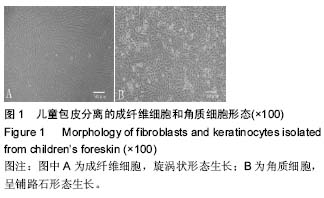
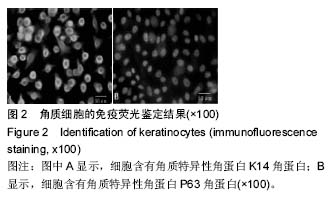
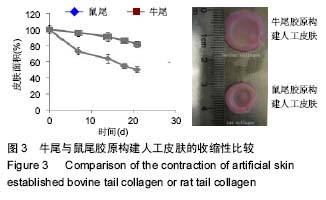
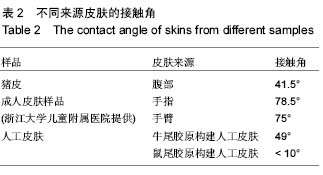
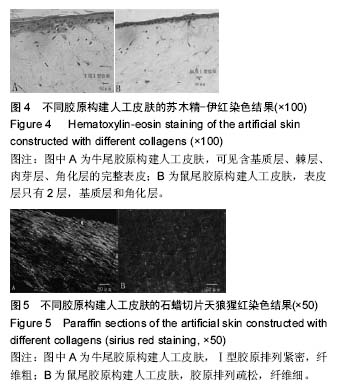
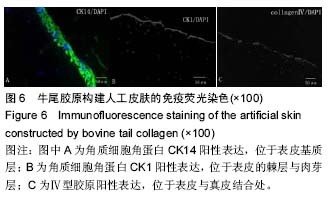
.jpg) 文题释义:
角质细胞培养方法:目前有2种方法,一种用特定的无血清培养基,如M199、F12MCDB153、KSFM、KGM,优点是无需饲养层细胞、培养方法简便易行;一种用鼠成纤维细胞系(NIH3T3)或者鼠胚胎成纤维细胞作饲养层,角质细胞铺在丝裂霉素C处理过的成纤维细胞饲养层上,优点是培养基含血清和高钙,细胞生长快传代方便,缺点是细胞更容易分化,传代次数低于3次。
体外构建人工皮肤:最初用饲养层来构建二维共培养模型,缺点是形成的皮肤寿命短,不能形成几层有序的角质层。其次将角质细胞种植于胶原包埋的成纤维细胞上,浸没培养7 d,随后气提培养获得人工皮肤,这一方法存在皮肤构建过程中胶原降解、胶原易收缩的缺点。目前已有研究采用3D 打印人工皮肤,不过存在成本高、成功率不高、皮肤表皮层不能分化为多层等缺陷。
文题释义:
角质细胞培养方法:目前有2种方法,一种用特定的无血清培养基,如M199、F12MCDB153、KSFM、KGM,优点是无需饲养层细胞、培养方法简便易行;一种用鼠成纤维细胞系(NIH3T3)或者鼠胚胎成纤维细胞作饲养层,角质细胞铺在丝裂霉素C处理过的成纤维细胞饲养层上,优点是培养基含血清和高钙,细胞生长快传代方便,缺点是细胞更容易分化,传代次数低于3次。
体外构建人工皮肤:最初用饲养层来构建二维共培养模型,缺点是形成的皮肤寿命短,不能形成几层有序的角质层。其次将角质细胞种植于胶原包埋的成纤维细胞上,浸没培养7 d,随后气提培养获得人工皮肤,这一方法存在皮肤构建过程中胶原降解、胶原易收缩的缺点。目前已有研究采用3D 打印人工皮肤,不过存在成本高、成功率不高、皮肤表皮层不能分化为多层等缺陷。